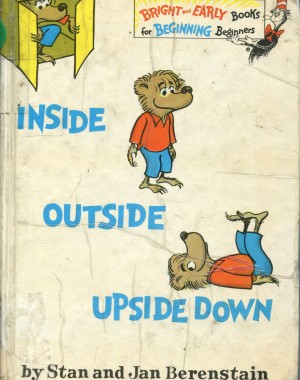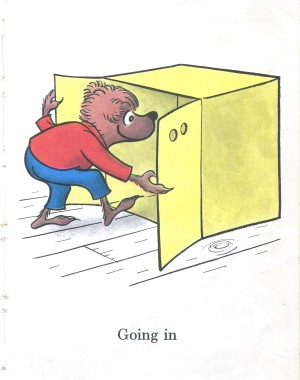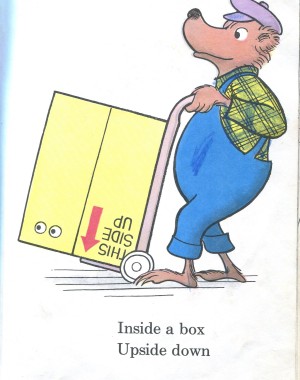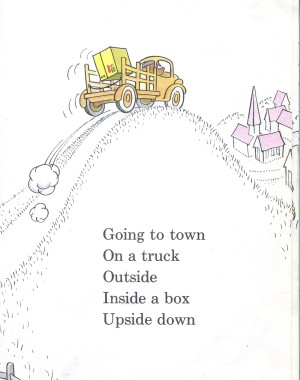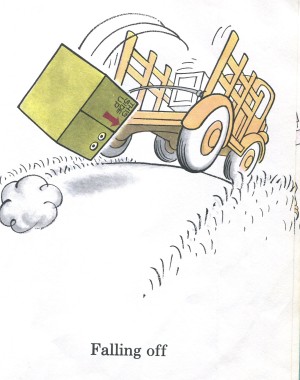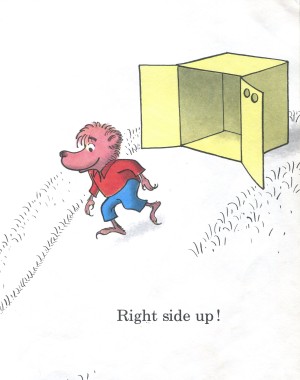I happened to take a look at an old book from my childhood “Inside, Outside, Upside Down” by Stan and Jan Berenstain, published in 1968 as an “Early and Bright Beginner Reader” book by Random House with that old familiar Cat-in-the-Hat logo. If you haven’t read it or don’t remember it, the select images on the slider below can give you some idea.
The plot is simple. A little bear (this was before Sister bear came along, so he wasn’t Brother bear yet) climbs into a box labeled “This Side Up” and soon enough Papa Bear comes by, the box is turned upside down and pushed outside onto a waiting truck. The box bounces around on back of the open truck until it falls off the back onto the open road and the little bear gingerly steps out of the box – right side up, and just outside his iconic treehouse home, delighted to tell his Mama Bear of his adventurous trip (half-way) to town, in a box, upside down, on a truck. It was probably a fun read as a little kid.
Reading it again as an adult had me take a double-take. Whoa! What a crazy story! Imagine a kid climbs into a box, gets (unknowningly?) carted off upside down (kidnapped!? by his own father!), loaded unsecured onto a waiting open truck, gets bounced around and thrown off the truck onto an open road… at least it ends well, but what message does this send to kids? What’s the point of the story? This is insane!
This question is compounded when considering the authors/illustrators Stan and Jan Berenstain, whose many books (later also TV shows) teach valuable and memorable life lessons to kids. Many of us remember “Too Much Birthday”, “Forget Their Manners”, “The Messy Room”, “Get in a Fight” and so many others. Even that other “Early and Bright Beginner Reader” classic “Old Hat, New Hat” has the obvious lesson of cherishing that which you already have. These authors obviously intend to convey positive and meaningful messages in their children’s books, so “Inside, Outside, Upside Down” seems to go against all that? It goes right against the grain of their writing style!*
I knew there must be a message in this story, so I reread the book once or twice more and looked closely at the illustrations. And then I saw it!
On every page, no matter what’s happening to that box, you see the little bear’s two eyes peeking out of the peek-holes in that box. Whether the box is right side up or upside down, on the truck or off, those two bold bright eyes don’t lose focus – they are there throughout.
A verse in Eccl. 9:8 reads: “The wise man’s eyes are in his head.” The Zohar asks: “Why, where else are a person’s eyes!?” Tanya chapter 35 has a different rich interpretation of this verse, but for our purposes here the point is: Don’t lose sight, keep focused, don’t let the box and external circumstances dictate your direction.
Let’s face it, in life we all get into boxes that we probably should not have. Things often end up upside down and exactly the opposite of our expectations. We often get shlepped into places and situations that we have little control over. And the ride isn’t always smooth, we get bounced around and thrown about, and a semse of security is one the least reliable things these days. People get thrown off the figurative truck all the time.
Little bears’ eyes represent vision and focus. If we have a determined sense of mission and purpose, if we keep our eyes on the goal, despite whatever turbulence, unsettling uncertainty and distractions of life – then we have a good chance of coming out of that crazy ordeal right side up, and close to home.
Don’t blink, don’t waver. Stay focused on the goal, remain constantly aware and in-touch with our individual and collective mission and inner-purpose. It’s not easy with all the ups and downs of life, and when things turn upside down on us. Stay focused! Don’t lose sight!
———-
* OK, those well-versed in Berenstain Bears may ask a Talmudic-style rebuttal from the likes of their “The B Book” which has some ridiculously crazy and dangerous scenes. And one can also argue that their focus on positive, meaningful messages began later in their writing career, but since I very much enjoy discovering hidden life messages in quality children’s literature, I prefer to seek out meaningful messages in all of their writings, when considering their overall and considerable body of work.
——–
We revisited this story again at a Shabbat Lunch in 2020, and this time UAlbany student Sydney M. shared this different take, an insightful commentary:
Perhaps this story is less about Little (Brother) Bear than it is about his father, Papa Bear. By the time Papa Bear came along, Little Bear was ensconced inside the closed box, so Papa Bear had no idea that his own son was inside. This rings true, as many times in life we have no idea what’s inside people’s “boxes” and have little clue as to the turmoil and trouble we might put them through – we’re not being cruel or have bad intentions, we just have no idea.
Rebecca W. Mordechai R. and Jason F. all shared variations on the theme of the twists and turns of life’s ups and downs and challenges, and the goal is to emerge intact, despite all that we went through: right side up, positive. It can be likened to an exodus of sorts, emerging from our personal Egypt (as Chassidus translates to be limitations).

